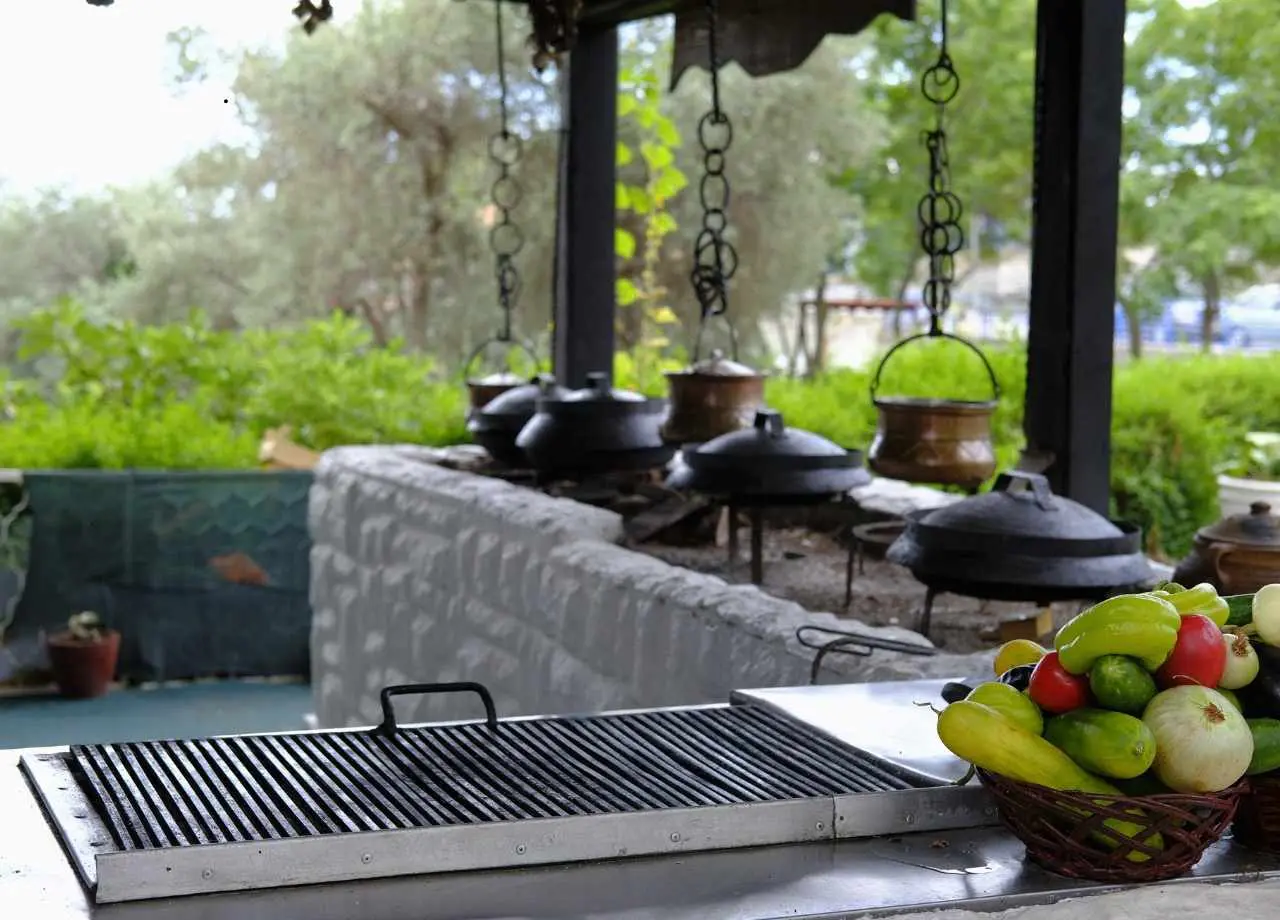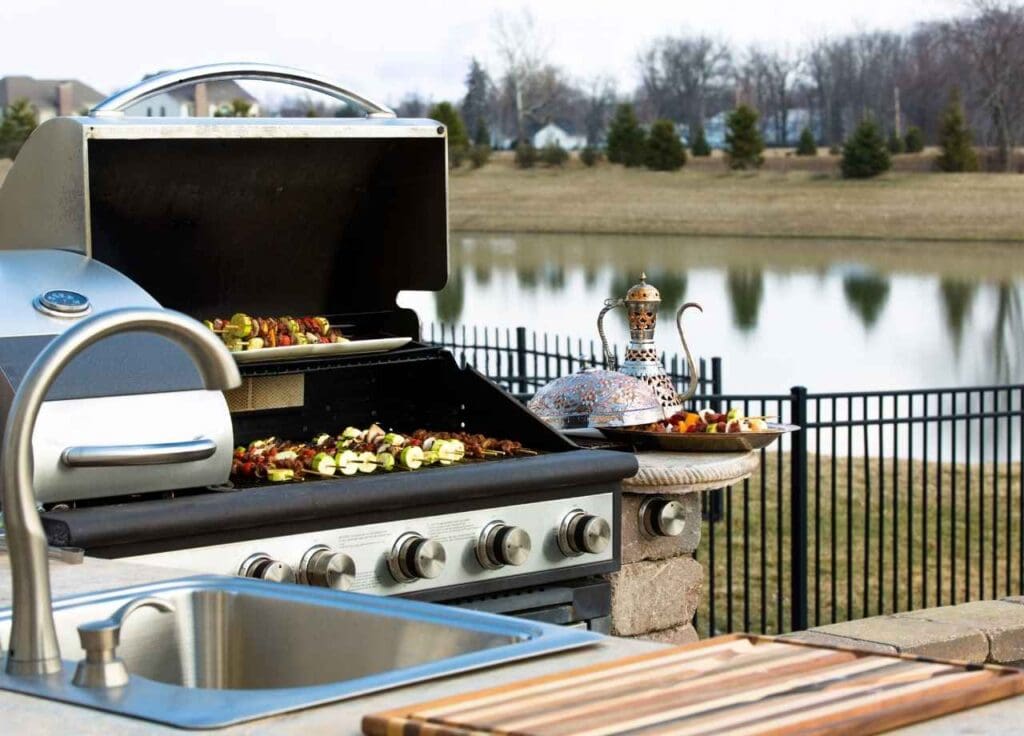
Outdoor Kitchen Side Burner Options: Features and Fuel Types
Side burners are the unsung workhorses of a well-designed outdoor kitchen. While the grill gets most of the glory, a side burner adds flexibility that can change the way you cook outside. Whether it’s sautéing vegetables while your steaks sear on the grill, boiling a pot of shrimp, or keeping sauces at just the right temperature, side burners handle the tasks your main grill isn’t built for. At Calico Outdoor, we build fully custom outdoor kitchens throughout Jacksonville and surrounding areas—and part of that process includes helping homeowners choose the right outdoor kitchen side burner to match their cooking habits and fuel preferences.
Table of Contents
What Is a Side Burner, Really?
A side burner is a separate cooking surface typically built into the countertop of your outdoor kitchen or attached to the side of a grill. It operates independently, giving you precise control over heat and allowing for multiple cooking techniques to happen at once. The basic idea is to give you the functionality of a stovetop burner outside, without having to run back and forth between the house and your grill island.
What makes a good side burner isn’t just heat output. It’s the design, fuel compatibility, and how well it integrates into your cooking routine. Not every outdoor chef needs a high-BTU powerhouse; others may want something more specialized. The right fit depends on how you cook and what you cook.
Standard Single Side Burners
Single side burners are compact and simple, making them ideal for smaller kitchens or those with limited counter space. Most single burners offer around 12,000 to 17,000 BTUs, which is plenty for simmering sauces, reheating sides, or boiling water for pasta. They’re typically built with stainless steel construction and often include a protective cover when not in use.
The simplicity of a single side burner doesn’t mean you’re sacrificing performance. Many high-end models offer precise heat control and heavy-duty grates that accommodate different pan sizes. They’re a solid option if you don’t need to cook multiple items on separate burners at once.
Dual Side Burners for Versatility
Dual side burners expand your outdoor kitchen’s capabilities. These feature two independently controlled burners, much like a traditional indoor range. That added burner means you can sauté on one side and boil on the other, or keep a dish warm while prepping something new.
Some dual side burners even include integrated lighting or push-button ignition, making them easier to use during late evening gatherings. If your outdoor kitchen is meant to function as a full meal-prep station, and not just a grilling hub, dual burners are worth considering.
Power Burners for High-Heat Cooking
Power burners are a different breed. Built for serious cooking tasks, these units offer between 25,000 and 60,000 BTUs or more. They’re designed for boiling large pots of water, wok cooking, frying, or anything else that requires sustained high heat.

They’re also larger in diameter and built with heavy-duty grates, often featuring inner and outer flame controls so you can dial in just the right temperature. Power burners are ideal if your cooking style involves seafood boils, stir-fries, or other high-volume, high-heat dishes.
This type of burner requires more space and often more fuel, but for some cooks, it’s non-negotiable. It turns an outdoor kitchen into a culinary workstation.
Infrared Side Burners
Infrared technology is known for its intense, even heat. While typically used in searing zones on grills, some manufacturers now offer infrared side burners. These reach high temperatures very quickly and maintain consistent heat across the surface.
They’re not ideal for everything—you wouldn’t want to simmer a sauce on one—but if you’re after high-speed searing or want to replicate steakhouse results with precision, they have their place. Just keep in mind they’re more specialized and may not be as versatile as other options.
Fuel Types: Natural Gas vs. Propane
When selecting a side burner, fuel source matters just as much as design or output. Most outdoor side burners are available in either natural gas (NG) or liquid propane (LP). Your decision often comes down to availability and how your outdoor kitchen is set up.
Natural gas is a popular choice for built-in outdoor kitchens because it connects directly to a home’s utility supply. It offers a steady, reliable fuel source without the need to swap tanks. If your property already has a gas line or you’re planning a new build, NG is worth the investment.
Liquid propane is more flexible. It doesn’t require a gas line and works well for portable or semi-permanent kitchens. Many homeowners prefer LP for the ease of setup and the ability to move equipment around when needed. The tradeoff is dealing with propane tanks and monitoring fuel levels more closely.
Some burners can be converted between fuel types with the right kit, but it’s best to choose the version that matches your existing setup to avoid complications later on.
Features That Actually Matter
Not every feature listed on a spec sheet will make a difference in real-world cooking. But a few stand out:
BTU rating: More isn’t always better. Choose a burner that fits your cooking style. Higher BTUs are great for large pots or quick boils, while lower BTUs work better for delicate tasks.
Ignition system: Look for electronic or push-button ignition. It’s faster and more reliable than manual lighters.
Construction quality: Stainless steel components (preferably 304 grade) resist corrosion and wear. Avoid flimsy builds that may degrade in coastal environments like Jacksonville.
Grate design: Heavy-duty grates improve heat retention and support heavier cookware. Removable grates make cleaning easier.
Wind guards: Often overlooked, but critical for outdoor performance. These help maintain flame control on breezy days.
Matching the Burner to the Kitchen
The side burner you choose should match the rest of your outdoor kitchen—not just in style, but in functionality. If you’re installing a full suite of cooking appliances, consider a dual or power burner for flexibility. For more compact kitchens, a single burner might be all you need.
Think about how often you’ll use the burner and for what kinds of meals. If it’s once a month to simmer a sauce, simplicity wins. If you’re hosting crab boils or cooking for a crowd, performance and size move to the top of the list.
Integration matters too. The burner should blend into your layout, not stand out awkwardly. It should be placed near prep areas, sinks, or the grill to make your cooking flow more intuitive.
Final Thoughts
A side burner isn’t just a convenience; it’s a tool that expands your outdoor kitchen’s capabilities. Whether you want a compact single burner or a heavy-duty power unit, the right choice depends on how you cook, the space you have, and your fuel setup. Matching features to function leads to better cooking, smoother gatherings, and fewer trips back to the indoor kitchen.
For homeowners in Jacksonville looking to build a full-featured outdoor kitchen, side burner selection is just one piece of the puzzle. Calico Outdoor helps you make smart choices from layout to appliances so your space works as good as it looks.
